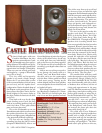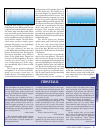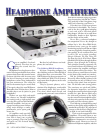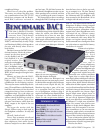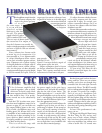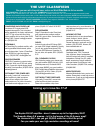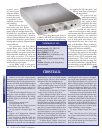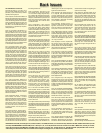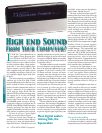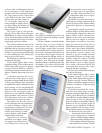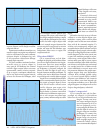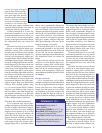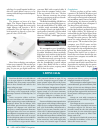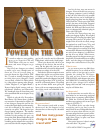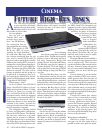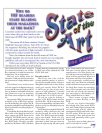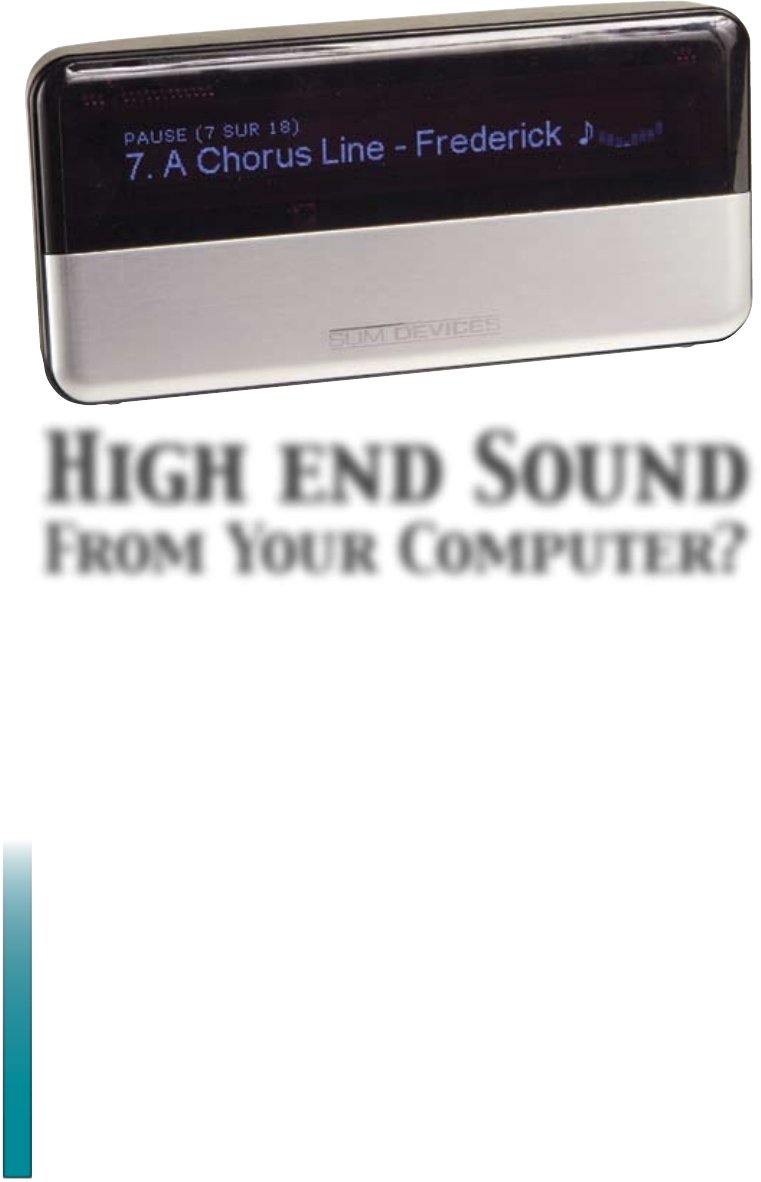
Feedback
Listening Room
I
n UHF No. 75 we explained how to
use Apple’s iTunes program (free
for Windows and Mac OS X) to
get instant access to a vast music
library. What was not evident was how
to listen without taking a huge perfor-
mance hit. A very few computers have
digital outputs, usually optical. But
your computer and your music system
are probably not adjacent. How do you
get a pristine digital signal from here
to there?
The most tempting way would be to
somehow get it out of an iPod. Unlike
most portable players, the iPod can carry
music around in either uncompressed
mode or lossless compression (more on
that in a moment), or no compression
at all. And the larger iPods, like the
official UHF iPod on the next page, have
the capacity for it. At first we thought
it would be a piece of cake to get the
digital signal from the iPod and into
an audiophile-grade converter. Wrong.
Converters expect to see digital data in
S/PDIF (Sony/Philips Digital Interface
Format), and that’s not what the iPod
supplies. Nonetheless we believe it can be
done, and we are pursuing our research.
So how do you get a good digital
signal over to your stereo system?
There are several ways, though we
think the little machine shown above is
the best we’ve seen: the Squeezebox 3,
from Slim Devices. This device is so well
thought out and does so much, that it is
difficult to believe it can be sold at such
a low price (US$299). Before we actually
get into setting it up, let’s look at what it
is and what it does.
The Squeezebox is a music controller
for your computer, except that it doesn’t
have to be connected physically to your
computer. If you have a wireless (Wi-
Fi) home network, as more and more
computer users do, it hooks on to that.
It can also connect by Ethernet, and
indeed there is an Ethernet-only version
available for $50 less. If you use a jukebox
program such as iTunes, the Squeezebox
can control it too. That means you can
use its remote to select any piece of
music that is in iTunes and call it up. If
you don’t use iTunes (as you can’t if your
computer runs Linux or Unix), Slim
Devices’ own software lets you do much
the same. The bright, large fluorescent
display shows you what’s on.
The rear of the device has a plethora of
connectors. You can plug in headphones,
or interconnects to your amplifier (there
is a built-in Burr-Brown DAC), or you
can use a coaxial or toslink digital cable
to put the digital signal right into your
own DAC, or into your one-box player’s
digital input. Enough for you?
But wait, as they say on late-night TV
infomercials, there’s more! You can set up
several Squeezeboxes, and they can be
playing different selections at the same
time, at least if your network has enough
bandwidth. If you get tired of the music
you own, you can also listen to Internet
radio, and you can set up the screen to
scroll through news headlines, stock
prices, or weather forecasts.
We do actually have a large collec-
tion of music on a hard disc, which is
there to feed our iPod (see The [High
Fidelity] Digital Jukebox in UHF No. 74).
Nearly all of it was compressed in Apple
Lossless, which as its name suggests
can compress music without doing irre-
versible damage. The Squeezebox also
handles the free lossless codec FLAC,
plus AAC, MP3, WMA (on Windows),
and lots more. What it can’t do is stream
protected music, such as that from
Apple’s iTunes store. Compressed music
from current stores is of little interest to
serious music listeners, however, and we
don’t consider that a dealbreaker.
Setting up the Squeezebox to con-
nect to our network was aided by clear
on-screen instructions. Once connected
it “saw” our massive iTunes collection
and gave us full access to it. From the
operational point of view, the Squeeze-
box is a wonder, marred only by a serious
security problem, which we will get to
shortly.
But we are audiophiles, and what we
really wanted to find out was whether
what the Squeezebox provides is some-
thing we would want to listen to. We set
it up in our Alpha system, with its digital
output (we tried both coaxial and optical)
feeding our Counterpoint DA-10A con-
verter. Our first observation: HDCD-
encoded recordings stored with Apple
Lossless compression maintain their
encoding. That much was interesting,
and since the code is found in the dith-
ering, it also means that very low-level
digital information is preserved through
encoding, decoding and transmission.
The proof of the pudding
A lot of our favorite test recordings
are already on hard disc, and that made
comparisons easy. We selected some CDs
High end Sound
From Your Computer?
Meet digital audio’s
missing link, the
Squeezebox
44 ULTRA HIGH FIDELITY Magazine



